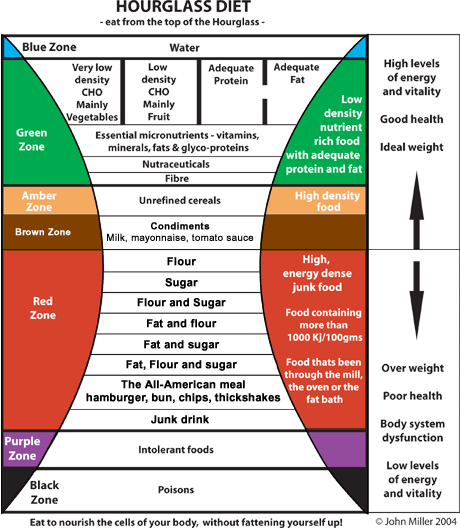There was a time in my life when I’d switched jobs, was living on my own, working long hours and stressing out. I was eating the wrong food (though I didn’t know it at the time). I ended up fat and crook. It was not a good feel.
I was working in an environment where I was obliged to preach the mantra of ‘eat more bread and pasta’. In an Epaminondas sort of a way I took my own advice. I kept eating ‘dat bread and de pasta’. It nearly did me in.
A friend recommended I visit a naturopath, which I did. It changed my life.
The naturopath said ‘Stop eating anything with wheat in it for a few days and see what happens.’ I followed his advice. 36 hours later I woke up at 6am, bright eyed and bushy tailed for the first time in a year; the fog had lifted.
Once I cut out the wheat flour, my health started improving and weight started to peel off.
To cut a long story short, I put on my thinking cap and developed the concept of the Hourglass Diet, where the good food is at the top of the hourglass and the junk and poison is at the bottom.

There are some unique features of the Hourglass Diet, among them the seven food zones and 22 food groups all neatly colour coded so you know immediately when you’re eating good food and when you’re eating junk.
Unlike other diet books The Hourglass Diet is not padded out with recipes. If you want recipes buy a magazine next time you’re at the super market or watch Master Chef, Iron Chef or Jamie, Gordon, Nigella, or Hestor …
The Hourglass Diet takes a critical look at other diet plans and concepts. With respect to the Pyramid have you noticed that the food that’s not good for you (chocolate, ice-cream, licorice …) is at the top of the Pyramid? It’s upside down!
The American Department of Agriculture has just developed a new model called My Plate but it’s the same old same old you’d expect from a committee of skinny dieticians – eat more bread and pasta.
In the grand scheme of healthy eating, the Glycemic Index is a side show, principally because the low GI bar has been set too high. As for the dietetic profession, there are too many people sharing pillow talk with the world’s largest manufacturers and purveyors of junk food.
The Hourglass Diet has one of the best junk food definitions you’ll ever see. No punch is pulled. In most diet books ‘junk food’ is the food that dares not speak its name for fear of giving offense to the junk food providers.
You’ll be amazed how much junk food out there is masquerading as good food. While the fat police were telling everyone to eat ’97% fat free’ and drink ‘skinny’ milk, the ‘garbohydrates’ snuck through on the inside and fattened everyone up.
‘Garbohydrates’? You won’t have heard of this term before but it describes the foods that are combinations of fat, flour, sugar and fried potato.
When the history of obesity is finally written, just remember where you first heard about the ‘garbohydrates’.
Most diet books are too simplistic; they’re just glorified sermons telling you to eat like either a sparrow or a rabbit.
However, for many people, eating to nourish the cells of the body without fattening themselves up is more complicated than that. For instance, if you can’t come to an understanding of why you’re not eating wisely you’ll just end up on the diet roller coaster, losing weight, gaining weight, losing weight, gaining weight … Or you’ll thrash yourself on the treadmill or the stepper as a way of burning off excess calories. Whatever, where I come from it’s called the rhythm method of girth control!
The Hourglass Diet overcomes the fat/thin/fat dilemma with the inclusion of a section on satisfying the inner hunger. You can’t satisfy the inner hunger by eating.
In a nutshell, what the Hourglass Diet does is set out the principles of healthy eating and once you’ve digested those principles, the recipes will look after themselves.
In the meantime stay tuned, highly tuned and eat from the top of the Hourglass.
John Miller